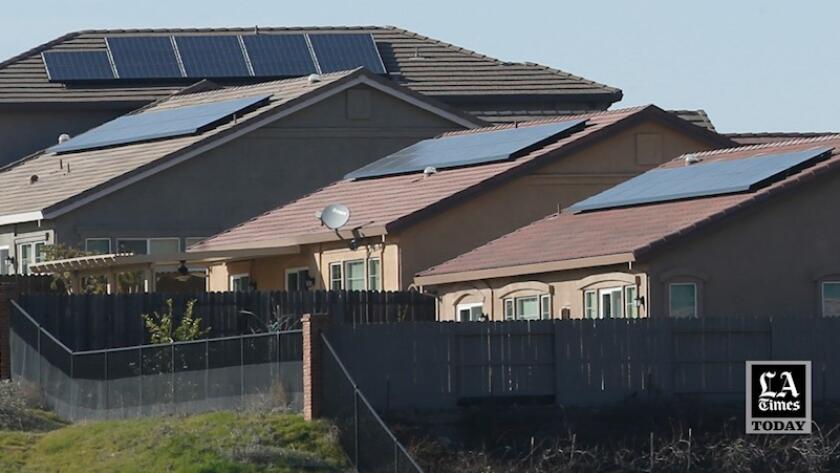How California’s new rooftop solar rules will affect you
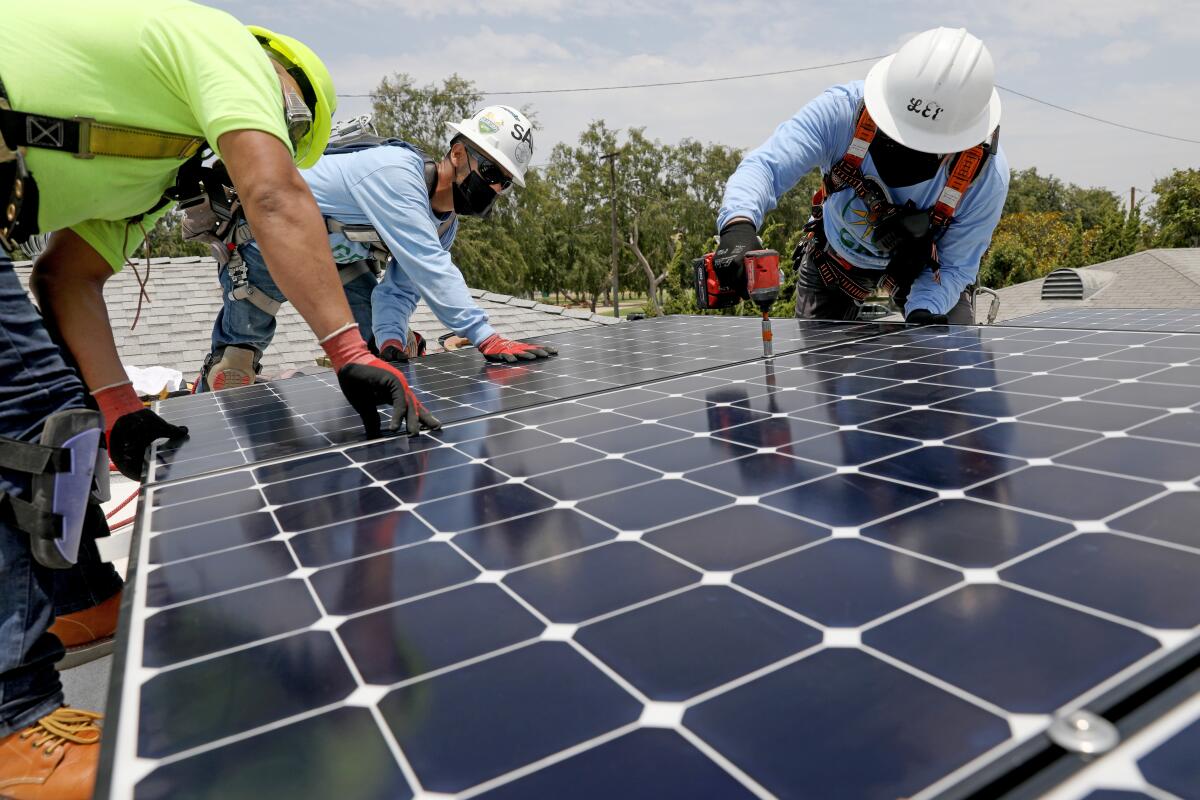
- Share via
This is the Dec. 22, 2022, edition of Boiling Point, a weekly newsletter about climate change and the environment in California and the American West. Sign up here to get it in your inbox.
The seismic shift coming to California’s rooftop solar market in 2023 has been brewing for nearly a decade.
A bill overwhelmingly approved by state lawmakers in 2013 ordered the California Public Utilities Commission — which regulates investor-owned utility companies — to rework a solar incentive program called net metering. Lawmakers directed the agency to ensure that the “total benefits” of the program were “approximately equal to the total costs” — meaning utility customers without rooftop solar panels weren’t paying more to subsidize their solar-powered neighbors than they should be.
But the bill also ordered the Public Utilities Commission to ensure that the solar market “continues to grow sustainably,” and to adopt incentives targeted at low-income families who might not be able to afford solar otherwise.
“We required the [commission] to design a program that does two things: create certainty for rooftop, and at the same time address the cost shift for non-solar customers,” then-Assemblymember Henry Perea, who wrote the legislation, told me in 2015. “It’s not an easy task.”
Most certainly not. The commission’s long-awaited decision, which I wrote about for The Times last week, spurred all sorts of fiery reactions. Solar installers and environmental activists said it would crater the market and put clean energy out of reach for far too many Californians, lower-income households in particular. The big utility companies — Southern California Edison, Pacific Gas & Electric and San Diego Gas & Electric — said it didn’t go far enough to reduce incentive payments, and would result in continued bill increases for their non-solar customers.
If you live in California, you may be wondering: What does this mean for you? If you already have solar, will you find yourself paying more? If you’ve been thinking about investing in solar — or adding a battery to your existing solar system — how have the economics changed? If you just want your monthly electric bill to stop going up, how much relief can you really expect?
I’ve got answers below. Take a read if you’re interested, or scroll down for this week’s top stories from around the West.
- Share via
Watch L.A. Times Today at 7 p.m. on Spectrum News 1 on Channel 1 or live stream on the Spectrum News App. Palos Verdes Peninsula and Orange County viewers can watch on Cox Systems on channel 99.
I want to go solar. Is it still a good idea?
You can definitely still save money with a rooftop system. It just might take longer than it did before.
Under the old rules, the expected “payback period” for homes served by Edison and PG&E was five to six years, according to an industry trade group. That means Edison and PG&E customers who bought solar panels — a purchase typically in the $20,000 range, once federal tax credits are taken into account — could expect to make back their upfront investment in five to six years through lower electric bills. After that, they’d continue to accrue bill savings for as long as their systems lasted.
SDG&E customers could expect an even shorter payback of four years, due to the utility’s especially high electric rates.
Starting in mid-April, when the new rules take effect, the calculation will change. The Public Utilities Commission has estimated a payback period of nine years for Edison and PG&E residential customers who go solar after April 13, and six years for homes served by SDG&E.
Solar installers say that’s too long for households that don’t have money to burn. They also think the commission used a lowball figure for the cost of solar, and thus underestimated how long it will take consumers to make back their investment.
Commission members have made the opposite argument, saying payback periods will probably be shorter than they’ve calculated. That’s because the agency’s calculations don’t account for the near-inevitability that electric rates will continue to rise, leading to higher monthly bill savings than they’ve estimated.
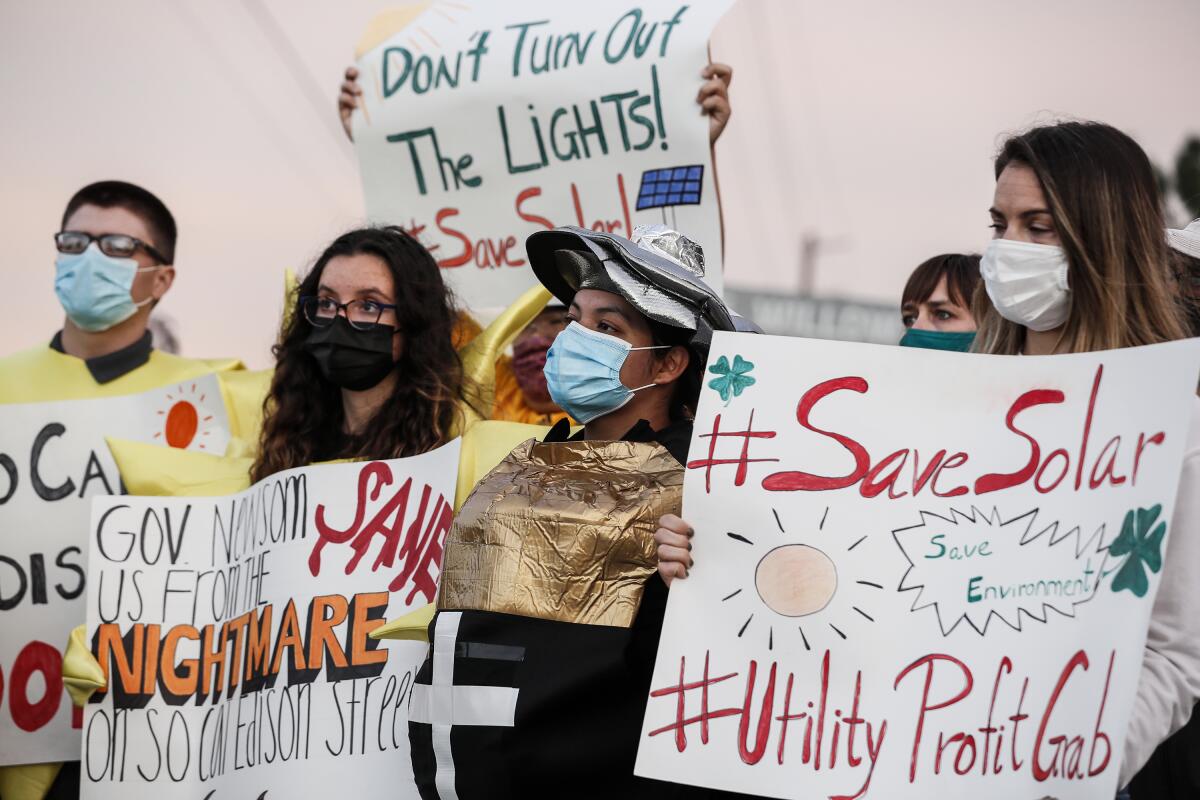
Are there extra incentives for low-income households?
Yes. Under the new rules, low-income homes enrolled in subsidized electricity programs known as CARE or FERA will receive higher payments for solar energy they export to the power grid — about 9 cents per kilowatt-hour above base payment rates for qualified Edison and PG&E customers who go solar during the first year after the new rules kick in. Higher-income Edison customers will get an additional 4 cents per kilowatt-hour, and higher-income PG&E customers will get just 2 cents.
But payback periods for low-income homes served by Edison and PG&E will still be an estimated nine years — no shorter than for higher-income homes. That’s because lower-income homes pay lower electric rates to begin with, and thus have less room to save.
Low-income SDG&E customers will see an estimated solar payback of 8.5 years, much longer than the six years projected for everyone else in the San Diego region.
Those numbers are a sore point for activists and companies focused on bringing clean energy to non-wealthy communities. In a written statement, the nonprofit solar installer Grid Alternatives said state officials are “gambling on a complicated incentive structure that uses a conservative estimate of project installation costs in order to achieve a targeted nine-year payback.”
“It remains to be seen whether this approach will truly achieve more environmental and economic justice,” the installer said.
In a last-minute change approved by the Public Utilities Commission, the higher payments to low-income homes won’t be available only to CARE and FERA customers. All homes on tribal lands and in communities considered “disadvantaged” will be eligible.
Activists applauded the change but said it wasn’t enough. Some had urged the commission to expand the higher payments to all households that earn 80% or less of area median income. But the agency declined to adopt that proposal, which Grid Alternatives criticized as “inconsistent with the [commission’s] own definition of environmental justice communities.”
What if I want a battery?
Then you’re in luck — at least if you can afford it.
The new rules are designed to encourage solar systems paired with batteries, which can relieve strain on the power grid by banking energy for hot summer evenings when the state has had trouble keeping the lights on. Southern California homes and businesses that export power to the grid on a September weeknight at 7 p.m. could be paid $2.58 per kilowatt-hour, according to a a solar industry trade group, compared with just 2 cents on an April afternoon at 3 p.m., when the state is often awash in cheap electricity.
The Public Utilities Commission’s estimated payback period for solar-plus-storage is 6.5 years for Edison and PG&E customers and less than five years for SDG&E customers. For low-income homes, the estimated paybacks are closer to nine years in Edison and PG&E territory and seven years in SDG&E territory.
Batteries add $10,000 or more in upfront costs once federal tax credits are taken into account. And installers warn that although costs have fallen dramatically over the last decade, the energy storage market is challenged by supply-chain constraints, labor shortages, inflation and other factors that could keep costs relatively high — and installations slow — in the near future.
“Permitting and interconnection times for solar-only projects are around 58 days on average,” said Mary Powell, chief executive of leading solar installer Sunrun. “Adding a battery means that same timeline goes to about 113 days on average.”
Just 14% of Californians who installed solar over the last year also added batteries. Whether that number rises significantly in the next few years will be a key indicator of the success — or failure — of the new rules.
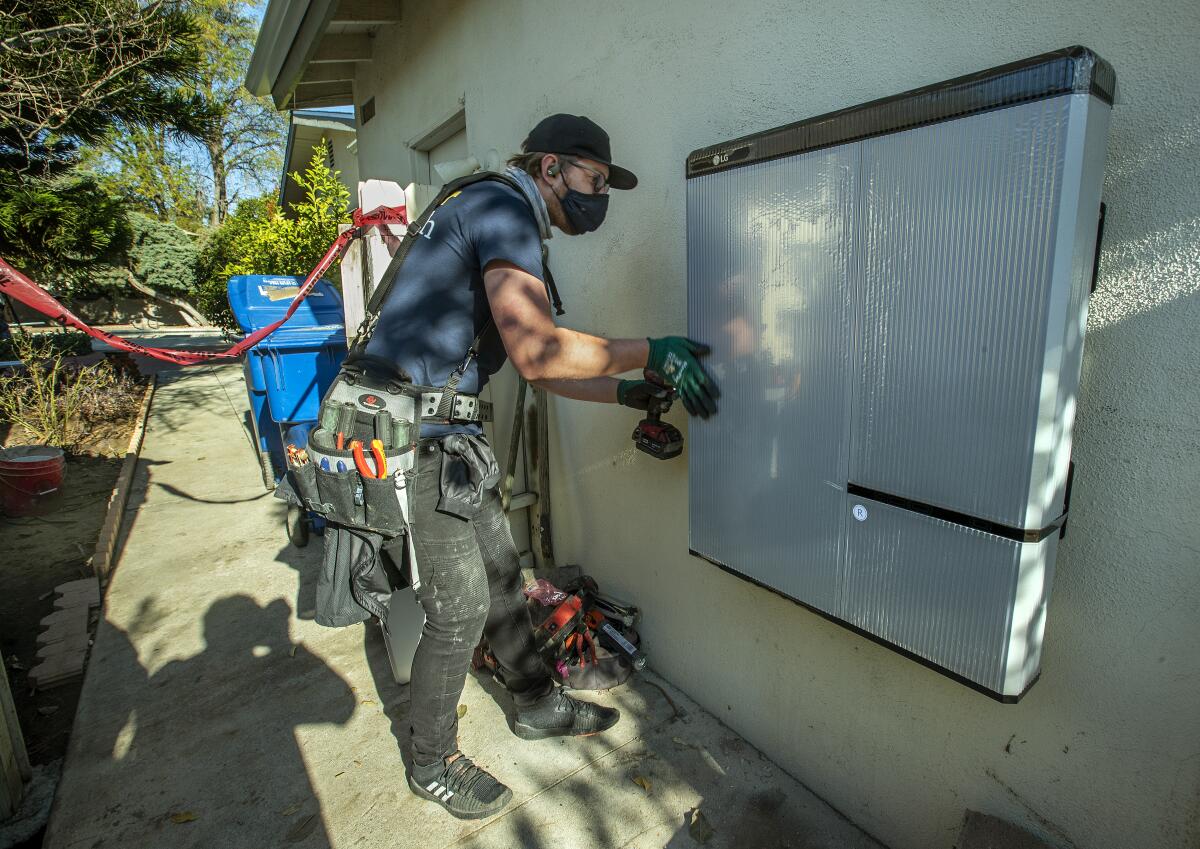
What if I want solar but don’t have tens of thousands of dollars?
About two-thirds of the 1.5 million rooftop solar systems in California are customer-owned, either purchased with cash or financed via a loan. The rest are leased, or paid for through “power purchase agreements” in which customers buy energy from the company that installs and maintains their panels. You can save more money long-term owning rooftop solar panels outright. But leases and PPAs are an option for families that don’t have the cash or credit score for a purchase.
It’s not yet clear how companies that focus on leases and PPAs — such as Sunrun — might change their offerings to respond to the new rules. But lower payment rates for solar are expected to result in lower monthly bill savings for customers.
New rebates from the state could help offset the lower savings for customers who lease or buy their systems. The Public Utilities Commission’s decision refers to an expected $900 million in new rebates or other incentives for rooftop solar and batteries, with $630 million set aside for low-income homes. But lawmakers still need to allocate those funds next year.
If net metering and upfront rebates don’t pencil out for you, there are other ways to improve the economics of solar, if you happen to live in the right spot. Some solar and storage companies have partnered with utilities or government-run “community choice” energy providers to build “virtual power plants,” where homes are paid for allowing their rooftop panels and batteries to be operated as part of a larger network that supports the grid as a whole.
Larger-scale “community solar” facilities that are serve entire neighborhoods are another option for renters, although California has lagged behind other states in this area. The Public Utilities Commission declined to address community solar in last week’s decision but is developing a new incentive program in a separate proceeding, as required by state law.
Also worth noting: Under an existing regulation, all new homes built in California are required to come with solar. Last week’s decision doesn’t change that.
I already have solar. Am I in trouble?
Nope. Under an earlier proposal from the Public Utilities Commission, many solar customers enrolled in net metering would have been switched to the lower incentive rates 15 years after their systems were installed. Now everyone who already has solar — or goes solar by April 13 — will get to keep operating under the old rules for the 20 years they were originally promised.
Also not in trouble: anyone whose electric utility isn’t Edison, PG&E or SDG&E. Existing solar incentives will remain in place at the Los Angeles Department of Water and Power, Sacramento Municipal Utility District and other utilities.
And what if you buy power from a government-run “community choice” energy agency such as Clean Power Alliance?
In that case, the new net metering rules still apply to you, because those agencies transmit power over the poles and wires owned by investor-owned utilities such as Edison. But some community choice agencies offer additional solar incentives.
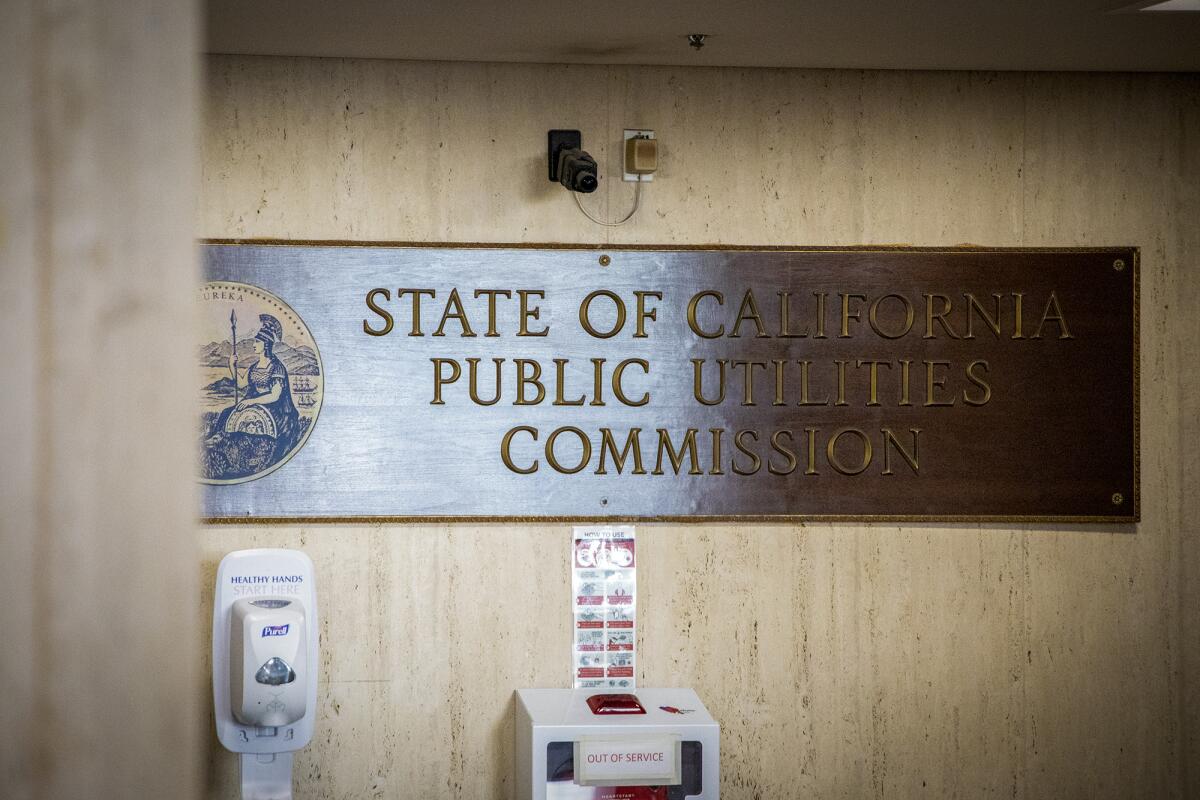
What if I want solar panels for my business?
Then the economics look a little tougher for you. Businesses that go solar during the first five years after the new rules take effect will receive lower payments than homeowners for electricity they export to the power grid. Schools and other non-residential utility customers will also receive lower payments than homeowners.
It’s another sore point for the solar industry. Installers are also unhappy that businesses that submit net metering applications between now and April 13 will need to have their systems completely installed within three years to maintain eligibility for the old rules. That may seem like a long time, but solar installers say there can be lengthy delays.
I don’t have solar. Will my electric bills go down?
As I wrote last week, almost certainly not.
Yes, the new rules are meant to reduce the “cost shift” being paid by non-solar homes to support their solar-powered neighbors. The Public Utilities Commission’s internal ratepayer watchdog estimates those payments at $4.6 billion this year.
But electric rates are being driven higher by all sorts of factors, including utility investments to reduce wildfire ignitions, upgrade aging transmission infrastructure and replace fossil fuels with cleaner energy. And rooftop solar advocates question whether the cost shift is nearly as big as some experts have estimated, or if it really exists at all.
Either way, rates are expected to keep rising significantly. But utility companies and ratepayer advocates hope that by cutting back on net metering, monthly bill increases won’t be as bad as they otherwise would have been.
“Realistically, rates will continue to increase. The big question is whether we can hold those increases to less than inflation,” said Matt Baker, director of the Public Advocates Office, the independent watchdog arm of the utilities commission.
In a separate regulatory proceeding, the Public Utilities Commission is considering a broader restructuring of electricity rates that could result in new monthly charges for solar-powered homes — and most other utility customers. Those charges would help pay for the costs of upgrading the power grid, and could be higher for higher-income homes.
OK, hopefully that answers your questions! And now, here’s what’s happening around the West:
TOP STORIES
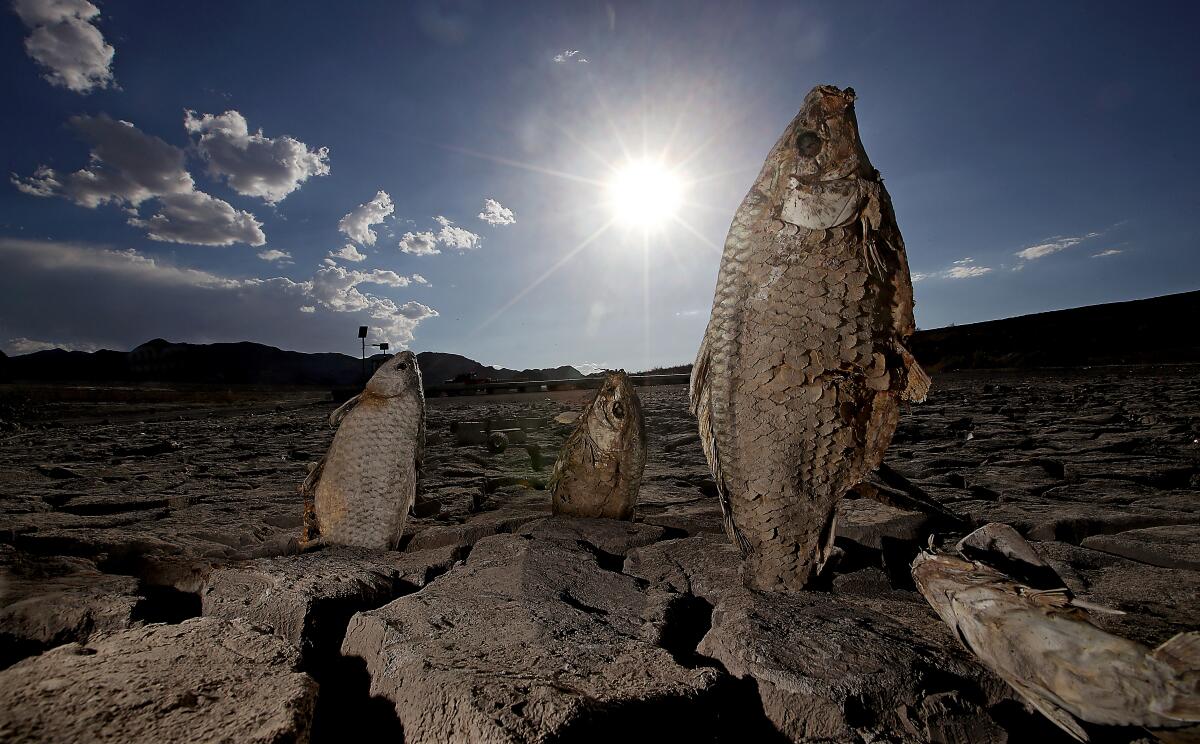
“Why don’t we recognize a water right for the Grand Canyon ecosystem? Why don’t we operate Glen Canyon Dam like a flood-control structure? Why don’t we clean out the sediment behind Lake Powell, and designate Glen Canyon National Park?” Those were the questions that one legal expert posed to my colleague Ian James in Las Vegas last week, at the annual conference of the Colorado River Water Users Assn. Ian wrote about growing fears of “dead pool” at Lake Mead, and about federal officials urging California and other Colorado River Basin states to agree to voluntary water cuts by Jan. 31. You may also be interested in the view from Arizona, where water plans being considered include desalination, raising the height of dams and investing in wastewater recycling in Southern California. Details here from the Arizona Republic’s Brandon Loomis.
Native American tribes filed a civil rights complaint against the California water board, arguing that the historic water-rights system barred them from inclusion and has allowed the fragile ecosystems of the Sacramento-San Joaquin River Delta to deteriorate. “As they divert our water, part of our culture is dying without us having a say,” one tribal leader told my colleague Hayley Smith. Elsewhere in the Central Valley, environmentalists are suing Bakersfield in hopes of restoring the flow of the Kern River through the city, Ian James reports. And in a beautiful final story for The Times, Diana Marcum writes about an enchanted botanical garden at the foot of the Sierra Nevada, not far from farm fields stricken by drought.
A new satellite that launched from California’s Vandenberg Space Force Base last week is expected to give scientists an unprecedented understanding of Earth’s rivers and seas, and how they’re being affected by climate change. “It turns the world’s water from 2D to 3D” is how one hydrologist explained the satellite’s purpose to The Times’ Corinne Purtill and Rosanna Xia. From 553 miles above Earth’s surface, they write, the satellite “will be the first to survey almost all the world’s surface water, allowing researchers to consistently track the volume and movement of every ocean, river, lake and stream on the planet.”
AROUND THE WEST

Beloved Los Angeles mountain lion P-22 was euthanized due to severe injuries, a decade after the puma managed to cross the 405 and 101 freeways and take up residence in Griffith Park. “Many Angelenos saw themselves in P-22, an aging bachelor who adjusted to a too-small space in the big city, waiting for a mate who might never arrive,” my colleagues Laura J. Nelson and James Queally write in their obituary for the cougar. James Rainey wrote about how P-22 changed many Angelenos’ relationship with nature, and how the city reacted to his death. Our photo staff compiled some amazing images.
New legislation in Congress would create Range of Light National Monument, protecting 1.4 million acres of roadless Sierra Nevada wilderness between Yosemite and Kings Canyon national parks. The name “range of light” comes from John Muir’s writings, per Kurtis Alexander at the San Francisco Chronicle. Farther north, environmentalists in the Pacific Northwest hope they’ll finally succeed in protecting vast swaths of wilderness outside Olympic National Park and Olympic National Forest during the lame-duck U.S. Senate session. They’ve been campaigning for decades, the Seattle Times’ Gregory Scruggs writes.
“A single therapy walk cannot erase the anguish of escaping the Camp fire... But those who have returned to the forest over and over say the program has been critical to their healing process.” Four years after the Northern California town of Paradise was mostly destroyed by flames, the Washington Post’s Sarah Kaplan has a gorgeous story about survivors working through their trauma by spending time in nature. The Post’s Joshua Partlow, meanwhile, wrote about the British Columbia town of Lytton, which burned to the ground last year one day after setting an all-time temperature record for Canada. After the fire, local leaders pledged to rebuild as a sustainable, fire-resistant community powered by climate-friendly energy. But the process has been so slow that some residents are working to scrap those plans in favor of faster rebuilding.
THE ENERGY TRANSITION
California officials approved the state’s latest long-term climate plan, which envisions a massive build-out of solar and wind power but which critics say includes too much reliance on carbon capture. Details here from Sophie Austin at the Associated Press. State officials also approved $2.9 billion to build 90,000 electric vehicle chargers. These moves are a big deal — in part because whatever California does on climate change, it’s likely others will follow suit. Just this week, Oregon adopted the Golden State’s ban on the sale of most new gasoline cars by 2035, as the Oregonian’s Gosia Wozniacka reports.
Nevada’s major electric company wants to spend $827 million building batteries, geothermal plants and gas turbines to meet energy demand on the hottest summer days. Warren Buffett-owned NV Energy says California’s electric-grid troubles are among the factors driving its plans, because the Golden State’s huge demand for power has led to fewer supplies available on the western market at peak times, Sean Hemmersmeier writes for the Las Vegas Review-Journal. More wind turbines in gusty New Mexico could help solve the problem. But some conservationists are fighting a planned electric line that would bring wind energy from the Land of Enchantment to California, saying the project would irreparably damage the Lower San Pedro River Valley, a wild refuge for birds and other animals. Here’s the story from Henry Brean at the Arizona Daily Star.
Billion-year-old rock in the Idaho Cobalt Belt could help fuel electric cars and solve the climate crisis. But environmental concerns abound in and around the Salmon River, a wild waterway known as the River of No Return, as Ian Max Stevenson and Kevin Fixler report in a fabulous deep dive for the Idaho Statesman. They dig into the global companies looking to mine huge amounts of cobalt, the political support they’ve secured and the delicate balance being sought by conservation activists.
AND EVERYTHING ELSE
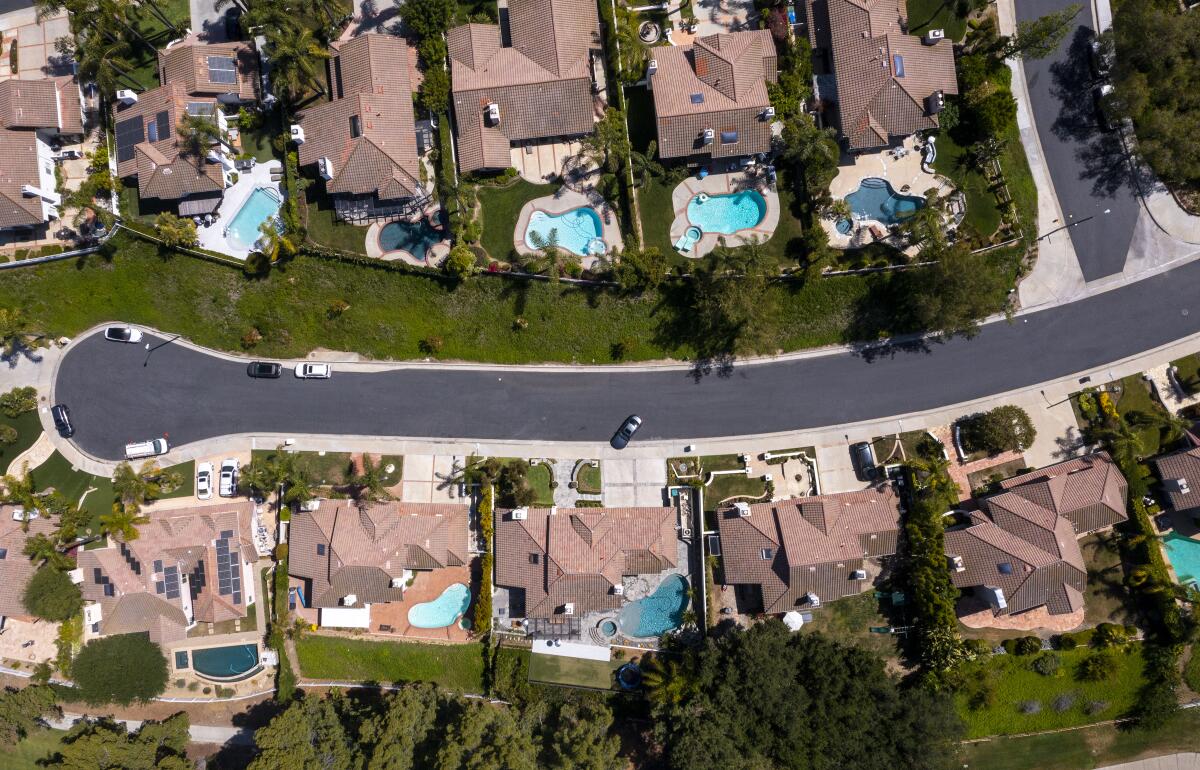
A celebrity-studded enclave in western Los Angeles County is investing in wastewater recycling. The area served by Las Virgenes Municipal Water District — home to Kim Kardashian — is almost entirely dependent on water imported from Northern California, but it should eventually be able to source 20% of its supplies locally, The Times’ Hayley Smith reports. Out in the Mojave Desert, thirsty bighorn sheep are getting their own water lifeline. California officials have given a nonprofit permission to install dozens of watering stations for the at-risk species, Brooke Staggs reports for the Orange County Register.
“If you thought the industry would slink away and accept its loss in Sacramento, you don’t know our oil drillers.” L.A. Times columnist Michael Hiltzik wrote about the fossil fuel industry’s campaign to overturn a newly enacted ban on drilling near homes and schools — and how it’s only the latest of example of deep-pocketed businesses bankrolling ballot measures to get rid of regulations they don’t like. Some drilling is still on the way out, though. A conservation nonprofit finalized the purchase of a coastal oil field in Orange County, with plans to preserve the property as open space, Hannah Fry reports.
“Delayed breaths and pauses for long, healthy growing years. Tighter sequences in years strained by drought or cut short by a passing wildfire scarring the bark, pausing progress.” I loved this story by the Arizona Republic’s Joan Meiners about scientists bringing tree rings to life with music, and trying to find harmony in the otherwise discordant work of studying climate chaos. I also enjoyed this profile by my colleague Jeanette Marantos of a photographer-turned-researcher documenting California’s endangered native bees. I had no idea there are bees as small as the size of a letter on a quarter!
ONE MORE THING
I wrote earlier this year about Southern California Gas Co.’s plan to spend billions of dollars building a huge hydrogen pipeline known as Angeles Link. The company told me the project could help L.A. transition away from fossil gas, and possibly allow for closure of the controversial Aliso Canyon gas storage field, which sprung a record-breaking methane leak in 2015.
In an early victory for SoCalGas, the California Public Utilities Commission voted last week to let the utility begin tracking the costs of planning the green hydrogen pipeline — not a guarantee that SoCalGas will be allowed to charge customers for those costs and eventually build the pipeline, but a necessary first step.
In a press release lauding the commission’s vote, the utility company said Angeles Link would “support significantly reducing greenhouse gas emissions from electric generation, industrial processes, heavy-duty trucks, and other hard-to-electrify sectors of the Southern California economy.”
Some climate activists are cautiously optimistic. But others are highly skeptical about green hydrogen. For a rundown of why, see this story by the Orange County Register’s Brooke Staggs, about students at UC Irvine protesting a SoCalGas plan to test hydrogen blending in pipelines on campus, citing safety concerns. SoCalGas canceled an interview for the story.
It’s also worth keeping in mind that the utility is a subsidiary of San Diego-based Sempra Energy, a Fortune 500 company heavily invested in natural gas. Just this week, the Biden administration agreed to let Sempra send gas to Mexico for export to Asia in exchange for Sen. Ted Cruz (R-Texas) lifting holds on four Energy Department nominees, Reuters’ Timothy Gardner reports.
I wrote last year about Sempra’s request to ship gas to Mexico, saying the Biden administration’s decision “could offer an early preview of how aggressively it will confront the climate crisis.” A lot has happened on climate since then — most notably passage of the Inflation Reduction Act — but when it comes to greenhouse gas emissions, all the pieces matter.
ACTUALLY, JUST ONE MORE

Tony Barboza, a member of The Times’ editorial board, wrote a heartbreaking, heartfelt commentary on the difficulty of talking with his kids about the climate crisis. It’s not easy reading. But it’s worthwhile, heading into the Christmas holiday.
“As an environmental reporter, I have written over and over about how the pollution we keep dumping into the air is hurting people, threatening ecosystems and endangering our future. But at home, I’ve struggled to explain this to my own daughters,” Tony writes. “Because being a father helped me grasp that humanity’s failure to address climate change is transgenerational violence against our own children and their future children and grandchildren.”
If you’ve got kids, or other young people in your life, Tony’s lessons and suggestions are worthwhile. Take a gander.
We’ll be back in your inbox next week. If you enjoyed this newsletter, or previous ones, please consider forwarding it to your friends and colleagues. For more climate and environment news, follow me on Twitter @Sammy_Roth.
Toward a more sustainable California
Get Boiling Point, our newsletter exploring climate change, energy and the environment, and become part of the conversation — and the solution.
You may occasionally receive promotional content from the Los Angeles Times.
